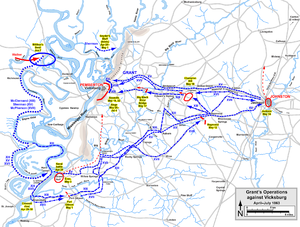Battle of Big Black River Bridge
| Battle of Big Black River Bridge | |||||||
|---|---|---|---|---|---|---|---|
| Part of the American Civil War | |||||||
 Grant's Operations against Vicksburg |
|||||||
|
|||||||
| Belligerents | |||||||
|
|
|
||||||
| Commanders and leaders | |||||||
|
|
|
||||||
| Units involved | |||||||
|
|
|
||||||
| Strength | |||||||
| 5,000 | |||||||
| Casualties and losses | |||||||
| 276 | 1,751 | ||||||
The Battle of Big Black River Bridge, or Big Black, fought May 17, 1863, was part of the Vicksburg Campaign of the American Civil War. Union commander Maj. Gen. Ulysses S. Grant and the Army of the Tennessee pursued the retreating Confederate Lt. Gen. John C. Pemberton following the Battle of Champion Hill, in the final battle before the Siege of Vicksburg.
Reeling from their defeat at Champion Hill, the Confederates reached Big Black River Bridge, the night of May 16–17. Pemberton ordered Brig. Gen. John S. Bowen, with three brigades, to man the fortifications on the east bank of the river and impede any Union pursuit. The Bridge was 1250 ft. long and 150 ft. tall.
Three divisions of Maj. Gen. John A. McClernand's XIII Corps moved out from Edwards Station (now the town of Edwards, Mississippi) on the morning of May 17. The corps encountered the Confederates behind breastworks of cotton bales fronted by a bayou and abatis. They took cover as enemy artillery began firing. Union Brig. Gen. Michael K. Lawler formed his 2nd Brigade, Eugene A. Carr's 14th Division, which surged out of a meander scar, across the front of the Confederate forces, through waist-deep water, and into the enemy's breastworks, held by Brig. Gen. John C. Vaughn's East Tennessee Brigade, which had little combat experience and was composed of men from largely pro-Union East Tennessee. The entire charge lasted 3 minutes.
...
Wikipedia
